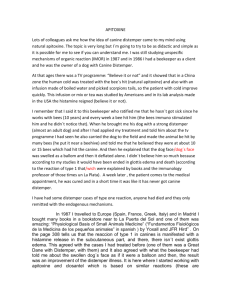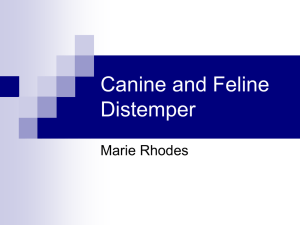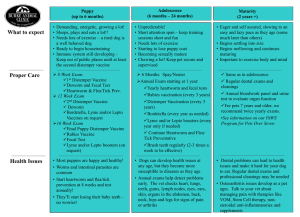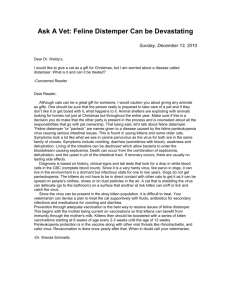CANINE DISTEMPER CAN BE CURED Dear colleagues, First of all
advertisement
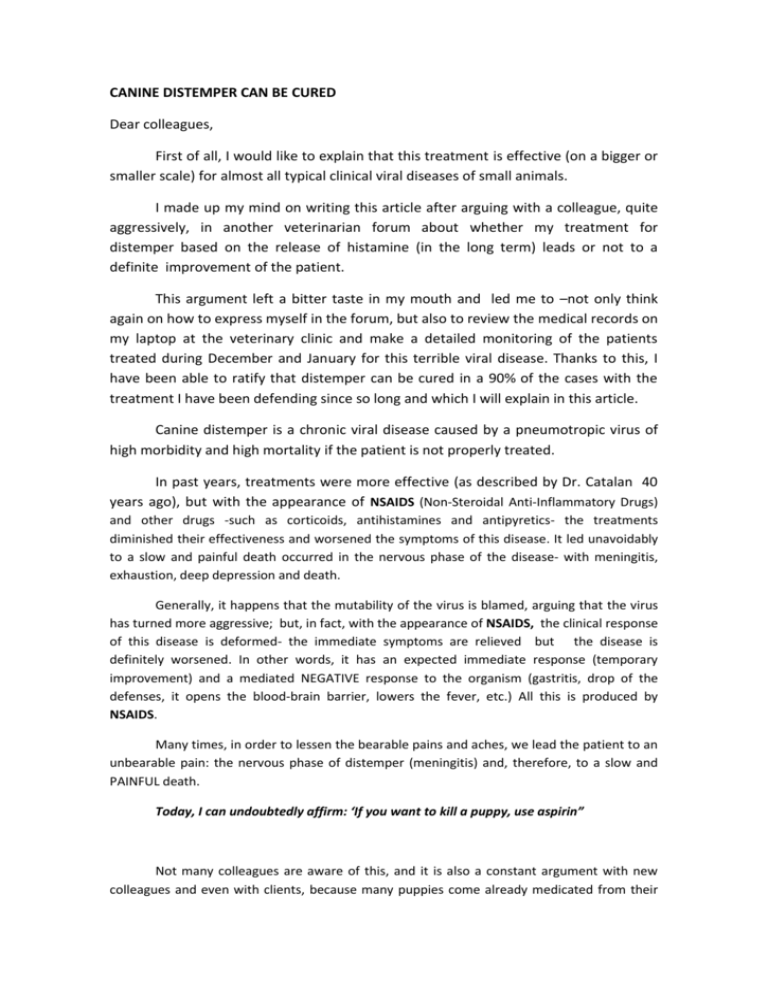
CANINE DISTEMPER CAN BE CURED Dear colleagues, First of all, I would like to explain that this treatment is effective (on a bigger or smaller scale) for almost all typical clinical viral diseases of small animals. I made up my mind on writing this article after arguing with a colleague, quite aggressively, in another veterinarian forum about whether my treatment for distemper based on the release of histamine (in the long term) leads or not to a definite improvement of the patient. This argument left a bitter taste in my mouth and led me to –not only think again on how to express myself in the forum, but also to review the medical records on my laptop at the veterinary clinic and make a detailed monitoring of the patients treated during December and January for this terrible viral disease. Thanks to this, I have been able to ratify that distemper can be cured in a 90% of the cases with the treatment I have been defending since so long and which I will explain in this article. Canine distemper is a chronic viral disease caused by a pneumotropic virus of high morbidity and high mortality if the patient is not properly treated. In past years, treatments were more effective (as described by Dr. Catalan 40 years ago), but with the appearance of NSAIDS (Non-Steroidal Anti-Inflammatory Drugs) and other drugs -such as corticoids, antihistamines and antipyretics- the treatments diminished their effectiveness and worsened the symptoms of this disease. It led unavoidably to a slow and painful death occurred in the nervous phase of the disease- with meningitis, exhaustion, deep depression and death. Generally, it happens that the mutability of the virus is blamed, arguing that the virus has turned more aggressive; but, in fact, with the appearance of NSAIDS, the clinical response of this disease is deformed- the immediate symptoms are relieved but the disease is definitely worsened. In other words, it has an expected immediate response (temporary improvement) and a mediated NEGATIVE response to the organism (gastritis, drop of the defenses, it opens the blood-brain barrier, lowers the fever, etc.) All this is produced by NSAIDS. Many times, in order to lessen the bearable pains and aches, we lead the patient to an unbearable pain: the nervous phase of distemper (meningitis) and, therefore, to a slow and PAINFUL death. Today, I can undoubtedly affirm: ‘If you want to kill a puppy, use aspirin” Not many colleagues are aware of this, and it is also a constant argument with new colleagues and even with clients, because many puppies come already medicated from their homes by their owners; and, generally, in a worse state due to the propaganda of NSAIDS and its transfer to HUMAN medicine, very different from the veterinarian one. I also read that there is a whole market of ideas and treatments, on the basis of an evident intention of making money over any treatment. There is also when we know by the name of MARKETING; but, behind all this, there is an INTELLECTUAL RESPONSIBILITY that evaluates immediate responses (PAINS) and does not evaluate the definite one, i.e.: THE PATIENT’S DEFINITE IMPROVEMENT. How to treat this chronic disease. Even if the Veterinary faculties follow Ettinguer school, who recommends in his works NSAIDS, corticoids, antipyretics and others; these should be CONTRAINDICATED, due to the fact that the owner will see a temporary improvement, but this will be later followed by a serious worsening that leads the patient to a nervous phase, and to a slow and painful death. Our treatment: Based on immune stimulators (histamine releasers), antibiotics, calcium and vitamin B, together with a balanced alimentation and preserving the patient from stressful situations (such as exposure to intense cold or keeping him caged). LA OXYTETRACYCLINE, today we use König’s “Kuramicina”: 1 cc each 30 kg, subcutaneously in rib cage every 96 hrs. We also use terramycine/LA (EVERY 72 hrs) or classic terramycine every 48 HRS. This may vary according to the patient’s stage or the patient’s general state. If the patient is too weak, the dose has to be reduced. Calcium and vitamin B1 B6 B12 (FOR REMYELINATION) If the patient has been previously medicated by its owners, it will be much more difficult to improve it. The ideal situation would be that the animal is brought to us showing symptoms such as bilateral conjunctivitis, the classical Kennel Cough (that may “invite” distemper if it is not already a symptom of its first phase) or a viral gastroenteritis in most cases. The disease lasts from 6 to 8 weeks. It starts with a bilateral conjunctivitis- it will be the first sign to appear and the last to disappear. It is necessary to explain that most viral diseases in puppies appear with a bilateral conjunctivitis; but then, the following symptoms will determine if it is distemper, hepatitis, or a viral gastroenteritis to parvo or corona. What matters is that, as the patient evolves, the treatment hereby proposed-because of being immune stimulator- benefits the patient no matter which viral disease he may be suffering. LA Oxytetracycline works through antibiotic (very effective in this respect) and histaminic (immune stimulator) pathways by forming a bubo or a granuloma that is reabsorbed after some days (depending on the dose, the type of drug applied and the patient). During these days, there is an extra release coming from the bubo and increasing histaminemia (very low in some viral diseases). My theory is that, through certain doses in blood, it functions as antibiotic (penicillinemia) (in high doses penicillinemia can also be toxic!) and, in increased doses of histamine in blood, it functions as viricide and antibiotic; and, in extremely high doses of histamine we can observe reactions of type 1 (in a dog it occurs almost always in its skin and very rarely it appears as vasodilatation of suprahepatic veins, but never as glottis and pulmonary edema. ) The viricide effect of “in Vitro” HISTAMINE has already been proved. In fact, allergic patients only suffer from their allergy and are generally really healthy, and they do not suffer from cancer either, as they do not suffer “any” disease. I am convinced that resistance of allergic patients to the disease is due to a high flowing histaminemia, and that is why they have a hyperactive immune-competent apparatus, much more developed than other, like an athlete has their skeletal muscle apparatus much more developed than an idle person. This article is addressed to the colleagues that have to deal with viral diseases, specially a distemper. It aims to provide them with tools to help the patient to cure their disease. I do not intend to generate aggressive arguments, BUT arguments that can enrich our knowledge through the exchange of opinions, experiences; so that we can realize that distemper CAN BE CURED as far as we treat it from an early stage (and not with NSAIDS and corticoids) Everyday, I have to treat puppies that suffer from this disease; and this article is not the result of researches on bibliography, but of my own daily experience. That is the reason why I intend to contribute with a treatment that will allow to cure the patient, even if the laboratories do not obtain substantial economical profits, because the medicine hereby needed is cheap and accessible. Maybe that is why, in the market, this TREATMENT is not really spread, because it is not economically profitable for laboratories; above all those that invest big sums of money in ‘supporting’ congresses and researches for making profit of them. In this aspect, forums play an important role , because, otherwise, it is very difficult to spread the info among colleagues, specially professors of clinics of small animals, who very much rely upon English speaking authors. Regarding those colleagues who do not treat many cases of distemper (and may hear that it does NOT work), I would recommend them to visit any Societies or associations for the Prevention of Cruelty to Animals, where you will find all the stages of distemper (due to the overcrowding and stress caused for it). I would also recommend them to collaborate with such associations because the medications are accessible. Once you have done all this, you can make your own conclusions and statistics. A variant for this treatment: In the cases of Feline viral rhinotracheitis (FVR), very common in Mendoza, we do not use LA Oxytetracycline, but the classic one and we add TINDALAC (Tyndalized milk), with amazing results when compared to other treatments. I hope the present work helps to exchange experiences, because I am convinced that the best part of these forums is what I call INTELLECTUAL GENEROSITY. Sergio de la Torre UNLP 1981 MENDOZA ARGENTINA This work can be sent as many times as you want, specially to professors at faculties of small animals.
